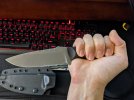Box_Opener
Gold Member
- Joined
- Aug 21, 2018
- Messages
- 949
I don't know much about knife fighting and certainly can claim no experience whatsoever, but this handle was also, (maybe primarily) designed to be wielded with the edge in, in that ice pick grip.
If the average person is defending their self with a knife, chances are pretty good they're already overwhelmed and their attacker is on them by the time they can get a knife out. In my experiments, holding the knife this way is quite damaging close in. With the edge inside the arc your arm makes in the stabbing movement, there is also cutting.
With the edge out, it strikes me that you'd be able to lever the handle with your thumb against an attacker's arm or leg or whatever, locking it in place. That was my thinking when imagining how the handle should work.
Obviously, if you have the presence of mind to perform these movements under duress then you know what you're doing, and I hope this knife works for that because I can't verify myself that it would. Always thought it would be great getting one in the hands of Doug Marcaida for his critique.
I think most people who design 'fighting' knives have never fought someone with a knife, so we just have to research things and think them through as best we can.
This is really interesting. I am no expert but I do know that one thing people overlook in actual weapon fighting is retention. Karambits have a mall ninja-ish reputation but a real one with a ring you put your finger through when drawn with a non-dominant hand is going to savagely cut anyone on top of you and be very hard to drop even with adrenaline coursing through you. Silat training aside, as something to encourage someone to get off you it is an excellent design which is why some police will carry one on their duty belt.
If you’re untrained and you fight with a weapon, your grip will do funny things like you’ll squeeze the handle extremely hard and your grip will become brittle because you don’t have the flexibility to readjust quickly while at the same time your muscles can’t squeeze that long without building crazy lactic acid. One of the few overlaps between fencing and kendo is that they both teach you to hold a weapon “like holding a live bird.” What’s interesting though is that both styles have this concept that you’ll be starting with some distance or at least without beginning in a grapple.
I don’t know where I’m going with this but grips are really interesting. It’s always cool to see how the concept of usage affects the design of a weapon. When I was a fencer I used to use child-sized visconti grip on my epees. Totally useless outside of the confines of a duellish fight but if you need to put a small piercing tip where it needs to go they were exceptional, at least for me. We all had to learn for almost three years on a french grip though, which is basically just a post with a slight curve in it. In Kendo, however, because the attacks are meant to cut and there is such a stress on continuity of tradition you don’t see anything so bizarre in the handles. Every shinai is basically the same except for the carbon fiber monstrosities and even those are just oval, like a katana, instead *of round.
*edit: of not or
Last edited:



